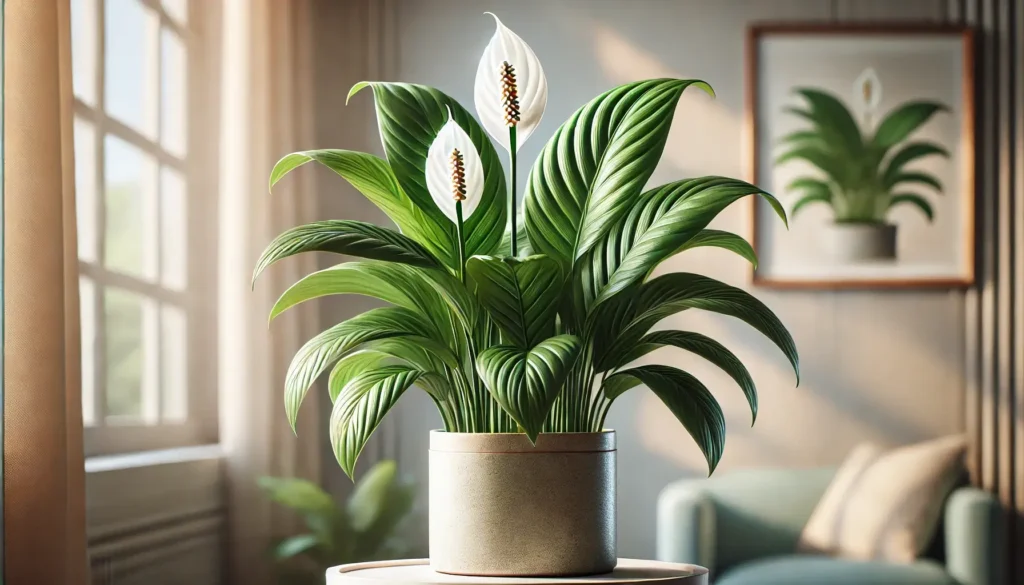The peace lily (Spathiphyllum) is a beloved houseplant known for its graceful white blooms, lush green foliage, and impressive air-purifying abilities. With its relatively low-maintenance nature, it’s perfect for both beginners and experienced plant enthusiasts. This guide will walk you through everything you need to know about caring for peace lilies, including light, watering, and propagation tips.
Peace Lily Plant Overview
- Scientific Name: Spathiphyllum wallisii (most common species)
- Common Names: Peace lily, spathe flower
- Origin: Tropical rainforests of Central and South America
- Family: Araceae (Arum family)
- Light: Low to moderate indirect light
- Watering: Keep soil evenly moist but not waterlogged
- Temperature: 65°F – 80°F (18°C – 27°C)
- Humidity: Prefers moderate to high humidity
- Toxicity: Toxic to pets and humans if ingested
How to Propagate a Peace Lily
Propagating peace lilies is best done through division, which involves separating the mature plant into smaller, rooted sections. This method works well during repotting in spring or summer, when the plant is most actively growing. Here’s how to do it:
- Choose a Healthy Plant: Look for a mature peace lily with multiple crowns (the points where leaves emerge).
- Prepare New Pots: Use well-draining pots and a suitable potting mix, such as a cactus or succulent mix, to ensure proper drainage (source).
- Gently Remove the Plant: Carefully loosen the soil and remove the plant from its current pot without damaging the roots (source).
- Divide the Plant: Separate the plant into smaller sections, ensuring each section has healthy roots.
- Repot the Divisions: Place each division into a new pot, water thoroughly, and place in an area with appropriate lighting (source).
Peace Lily Care Guide
For a healthy and flourishing peace lily, follow these essential care tips:
- Light: Peace lilies thrive in bright, indirect light but can tolerate lower light levels. Avoid direct sunlight, as it can scorch the leaves. In low light, growth may slow, and flowering may be less frequent (source).
- Watering: Keep the soil evenly moist, but don’t allow it to become soggy. Water when the top inch of soil feels dry. Peace lilies are sensitive to overwatering, which can lead to root rot (source).
- Humidity: As tropical plants, peace lilies love humidity. Mist the leaves regularly or place the pot on a tray filled with water and pebbles to increase humidity levels (source).
- Temperature: Maintain a comfortable room temperature between 65°F and 80°F (18°C – 27°C). Keep the plant away from drafts, air conditioning vents, and cold windows, as peace lilies are sensitive to temperature fluctuations (source).
- Soil: Use a well-draining potting mix that holds moisture but allows excess water to escape. A mix designed for tropical plants or houseplants works well (source).
- Fertilizer: Feed your peace lily every 4 to 6 weeks during the growing season (spring and summer) with a balanced, water-soluble fertilizer. Stop fertilizing in the fall and winter when the plant’s growth slows (source).
- Pruning: Regularly remove any yellowing or brown leaves to encourage new growth and keep the plant looking its best (source).
Troubleshooting Common Peace Lily Problems
- Drooping Leaves: This often indicates underwatering. Water the plant thoroughly and allow the excess to drain. The leaves should perk up within a few hours (source).
- Brown Leaf Tips: Dry air, low humidity, or inconsistent watering may cause brown tips. Increase humidity and check your watering schedule (source).
- Yellow Leaves: Yellowing leaves are usually a sign of overwatering or poor drainage. Check the soil moisture, and if necessary, repot the plant into fresh, well-draining soil (source).
- Lack of Blooms: If your peace lily isn’t flowering, it may need more light. Move the plant to a brighter spot, but avoid direct sunlight (source).
Peace Lilies and Air Purification
Peace lilies are known to improve indoor air quality by absorbing harmful chemicals like formaldehyde, benzene, and carbon monoxide. According to NASA’s Clean Air Study, they are one of the top houseplants for air purification.
However, keep in mind that peace lilies are toxic to both pets and humans if ingested. To ensure safety, place the plant out of reach of curious pets and children (source).
Wrap Up
With minimal effort, peace lilies can thrive and bring a touch of elegance to any indoor space. By following the simple guidelines in this care guide—providing the right light, moisture, and occasional feeding—you can enjoy a healthy, long-lasting plant.
Happy growing!

